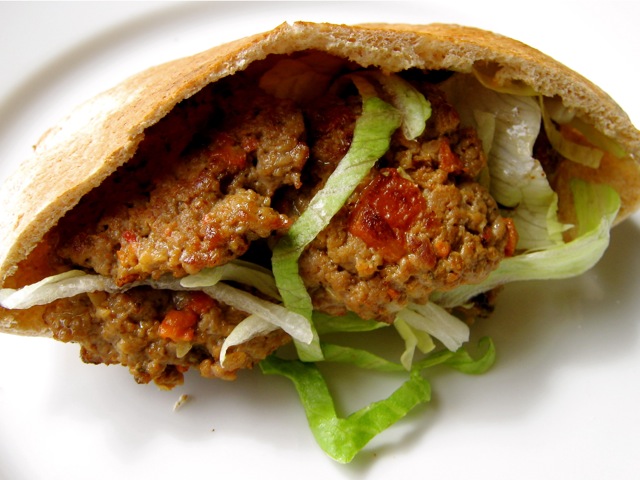
reference-image, l
(article, Matthew Amster-Burton)
[%pageBreakSettings nobreak=true] Things are looking up in the meat department at my local supermarket. In the last two years they've started carrying organic chicken and hormone- and antibiotic-free beef (including dry-aged and USDA Prime). But the sausage selection is behind the times. In fact, finding excellent fresh sausage isn't easy to do, period. Perusing the sausage case, there's one good local brand (Isernio's), but everything else is made with corn syrup, musty dried herbs, and preservatives such as butylated hydroxyanisole (BHA). Yum. There are chicken sausages that are far too lean to be tasty, and no lamb sausage to speak of, even though lamb sausage can be outrageously good. [%image reference-image float=right width=400 caption="Homemade lamb sausage tucked inside a pita for a sandwich."] So I often make my own sausage, and if you love sausage, you should do the same. You can control exactly what goes into it. You can make a variety of sausages unavailable in your local market. You can begin with the best local meat. You can use tons of homegrown fresh herbs. You can make fresh sausage so flavorful that a little goes a long way, and thereby encourage yourself to use meat as a flavoring rather than the main event, just like Mark Bittman told you to. Wait, where are you going? Look what I'm not going to ask you to do: Stuff casings. I've done it once. That was plenty. Now I make bulk sausage, which is extremely versatile. Smoke or dry sausages. Not in my apartment. (In fact, as much as I like you, readers, I'd rather you didn't do any of your sausage-making in my apartment.) Work with pork fatback. I do buy and use pork fat regularly, but it's not necessary for good homemade sausage if you start with the right cuts of meat: shoulder cuts of beef, pork, and lamb, and leg and thigh meat of duck, chicken, and turkey. Now that you’ve calmed down instead of fleeing in terror, let's begin. You'll need two pieces of equipment to make sausage: a stand mixer and its food-grinder attachment. Grinders are available for KitchenAid, Viking, and Cuisinart stand mixers. The stand mixer attachments work better than inexpensive standalone electric meat grinders; they're also easier to clean and store. Some people grind meat in the food processor. I have never mastered this and wouldn't recommend it unless you're already doing it successfully. For your first forays into home sausage making, you'll want a foolproof setup. A third, optional piece of equipment is a spice grinder, as freshly ground spices really shine in sausage. Get one of those cheap little propeller-bladed coffee grinders (your local Goodwill will probably have one, if you’re über-cheap) and use it for spices, not coffee. No matter what kind of sausage you're making, here's the procedure: # Cut the meat into 1-inch chunks. # Season with herbs, spices, aromatics, and salt. (Not to mention dried or fresh fruit, roasted peppers, and any member of the onion and garlic family.) # Grind through the fine plate (the one with the smaller holes). # Stir in a bit of flavorful liquid (wine, vinegar, beer, cider) to help bind the sausage together. At this point, you can cook a small patty of sausage, taste it for seasonings, and stir in whatever else it needs. Like cookie recipes, most sausage formulas yield enough to feed a crowd. But I'd suggest making a pound at a time until you find a sausage you really love. Then you can make more and freeze it. I've had great luck freezing sausage with my vacuum sealer, the Reynolds Handi-Vac that I paid $9 for when I was experimenting with cilantro preservation. You've probably heard that it's vital to keep everything cold while making sausage. This is true up to a point. You'll want to start with refrigerated (or even lightly frozen) meat, and it can't hurt to put the grinder attachment in the freezer while you're prepping ingredients. But it takes about one minute to grind a pound of sausage, not enough time for the materials to heat up. So you don't need to bother using an ice-water bath as long as you get the sausage right into the fridge when you're done. The best source for homemade sausage recipes, at least until you're experienced enough to improvise your own, is Michael Ruhlman and Brian Polcyn's book Charcuterie. If you use this book, be forewarned that I've found every recipe to be oversalted; start by cutting the salt in half and add additional salt if necessary. [[block(sidebar). h1.Featured recipes ]] If you're still unconvinced that this can possibly be easy, quick, or convenient, consider this: Today I made the North African lamb sausage called merguez. My supermarket, it turns out, will happily cut cubes of boneless lamb shoulder upon request. As a result, the whole sausage-making session, including setup and cleanup, took 30 minutes, and the sausage is fantastic: spicy, juicy, and ready to be stuffed into a pita for lunch tomorrow. Since I had the grinder set up and some leftover chicken thighs in the fridge (and my brain was in sausage mode), I also made some chicken-basil-tomato sausage with fresh basil and canned tomatoes. Recently I've also made Mexican chorizo and ginger-sage breakfast sausage, using recipes in Charcuterie. Now I have a bunch of sausage in my freezer, so I'd better get to eating it. In the meantime, if you need me, ask for Abe Froman. p(bio). [matthew.reviews@gmail.com "Matthew Amster-Burton"]* writes about cooking and culture from his home in Seattle. He keeps a blog titled Roots and Grubs.

reference-image, l